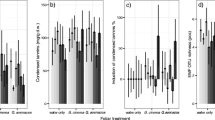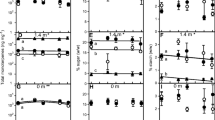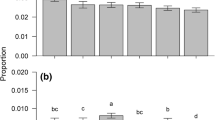Abstract
Despite their economic and ecological importance, defense responses of conifers to pests are little understood. In a 3-year experiment, we monitored systemic fungal (Diplodia pinea)- and insect (Neodiprion sertifer)-induced defense protein activities and total soluble proteins in needles and phloem of Austrian pine (Pinus nigra) across a soil fertility gradient. In both years, total soluble protein content of foliage and phloem declined with increasing fertility across induction treatments, while defensive protein activities generally increased with increasing fertility. In 2005, total soluble protein content in branch phloem was increased by fungal inoculation of the stem. Peroxidase activity was suppressed in needles by insect defoliation in 2006, while polyphenol oxidase activity was systemically induced in branch phloem by insect attack in 2005. Trypsin inhibitor activities in phloem did not respond to any induction or fertility treatment. Nutritive quality of Austrian pine tissue declined with increasing fertility, while several protein-based defenses simultaneously increased.






Similar content being viewed by others
References
Abeles, F. B., and Forrence, L. E. 1970. Temporal and hormonal control of β-1.3-glucanase in Phaseolus vulgaris L. Plant Physiol. 45:395–400.
Blodgett, J. T., Herms, D. A., and Bonello, P. 2005. Effects of fertilization on red pine defense chemistry and resistance to Sphaeropsis sapinea. For. Ecol. Manag. 208:373–382.
Bolter, C. J., Latoszek-green, M., and Tenuta, M. 1998. Dependence of methyl jasmonate- and wound-induced cysteine proteinase inhibitor activity on nitrogen concentration. J. Plant Physiol. 152:427–432.
Bonello, P., and Blodgett, J. T. 2003. Pinus nigra–Sphaeropsis sapinea as a model pathosystem to investigate local and systemic effects of fungal infection of pines. Physiol. Mol. Plant Pathol. 63:249–261.
Borowicz, V. A., Albrecht, U., and Mayer, R. T. 2003. Effects of nutrient supply on Citrus resistance to root herbivory by Diaprepes abbreviatus L. (Coleoptera: Curculionidae). Environ. Entomol. 32:1242–1250.
Cipollini, D. F. 2002. Does competition magnify the fitness costs of induced responses in Arabidopsis thaliana? A manipulative approach. Oecologia 131:514–520.
Cipollini, D. F., and Bergelson, J. 2001. Plant density and nutrient availability constrain constitutive and wound-induced expression of trypsin inhibitors in Brassica napus. J. Chem. Ecol. 27:593–610.
Cipollini, D. F., Enright, S., Traw, M. B., and Bergelson, J. 2004. Salicylic acid inhibits jasmonic acid-induced resistance of Arabidopsis thaliana to Spodoptera exigua. Mol. Ecol. 13:1643–1653.
Eyles, A., Chorbadjian, R., Wallis, C., Hansen, R., Cipollini, D., Herms, D., and Bonello, P. 2007. Cross-induction of systemic induced resistance between an insect and a fungal pathogen in Austrian pine over a fertility gradient. Oecologia 153:365–374.
Franceschi, V. R., Krokene, P., Christiansen, E., and Krekling, T. 2005. Anatomical and chemical defenses of conifer bark against bark beetles and other pests. New Phytol. 167:353–376.
Haruta, M., Pedersen, J. A., and Constabel, C. P. 2001. Polyphenol oxidase and herbivore defense in trembling aspen (Populus tremuloides): cDNA cloning, expression, and potential substrates. Physiol. Plant. 112:552–558.
Hodge, A., Alexander, I. J., and Gooday, G. W. 1995. Chitinolytic activities of Eucalyptus pilularis and Pinus sylvestris roots systems challenged with mycorrhizal and pathogenic fungi. New Phytol. 131:255–261.
Inbar, M., Doostdar, H., and Mayer, R. T. 2001. Suitability of stressed and vigorous plants to various insect herbivores. Oikos 94:228–235.
Inbar, M., Doostdar, H., S, onoda, R. M., Leibee, G. L., and Mayer, R. T. 1998. Elicitors of plant defensive systems reduce insect densities and disease incidence. J. Chem. Ecol. 24:135–149.
Johansson, S. M., Lundgren, L. N., and Asiegbu, F. O. 2004. Initial reactions in sapwood of Norway spruce and Scots pine after wounding and infection by Heterobasidion parviporum and H. annosum. For. Pathol. 34:197–210.
Jøhnk, N., Hietala, A. M., Fossdal, C. G., Collinge, D. B., and Newman, M.-A. 2005. Defense-related genes expressed in Norway spruce roots after infection with the root rot pathogen Ceratobasidium bicorne (anamorph: Rhizoctonia sp.). Tree Physiol. 25:1533–1543.
Karban, R., Adamchak, R., and Schnathorst, W. A. 1987. Induced resistance and interspecific competition between spider mites and a vascular wilt fungus. Science 234:678–680.
Larsson, S., Ekbom, B., and Björkman, C. 2000. Influence of plant quality on pine sawfly population dynamics. Oikos 89:440–450.
Lippert, D., Chowrira, S., Ralph, S. G., Zhuang, J., Aeschliman, D., Ritland, C., Ritland, K., and Bohlmann, J. 2007. Conifer defense against insects: proteome analysis of Sitka spruce (Picea sitchensis) bark induced by mechanical wounding or feeding by white pine weevils (Pissodes strobii). Proteomics 7:248–270.
Liu, J.-J., Ekramoddoullah, A. K. M., and Yu, X. 2003. Differential expression of multiple PR10 proteins in western white pine following wounding, fungal infection and cold-hardening. Physiol. Plant. 119:544–553.
Liu, J.-J., Ekramoddoullah, A. K. M., and Zamani, A. 2005. A class IV chitinase is up-regulated by fungal infection and abiotic stresses and associated with slow-canker-growth resistance to Cronartium ribicola in Western White Pine (Pinus monticola). Phytopathology 95:284–291.
Major, I. T., and Constabel, C. P. 2008. Functional analysis of the Kunitz trypsin inhibitor family in poplar reveals biochemical diversity and multiplicity in defense against herbivores. Plant Physiol. 146:888–903.
Mcintyre, J. L., Dodds, J. A., and Hare, J. D. 1981. Effects of localized infections of Nicotiana tabacum by tobacco mosaic virus on systemic resistance against diverse pathogens and an insect. Phytopathology 71:297–301.
Musser, R. O., Cipollini, D. F., Hum-Musser, S. M., Williams, S. A., Brown, J. K., and Felton, G. W. 2005. Evidence that the caterpillar salivary enzyme glucose oxidase provides herbivore offense in Solanaceous plants. Arch. Insect Biochem. Physiol. 58:128–137.
Peterson, G. W. 1977. Infection, epidemiology, and control of Diplodia blight of Austrian, ponderosa, and Scots pine. Phytopathology 67:511–514.
Pirttilä, A. M., Laukkanen, H., and Hohtola, A. 2002. Chitinase production in pine callus (Pinus sylvestris L.): a defense reaction against endophytes? Planta 214:848–852.
Ralph, S. G., Jancsik, S., and Bohlmann, J. 2007. Dirigent proteins in conifer defense II: extended discovery, phylogeny, and constitutive and stress-induced gene expression in spruce (Picea spp.). Phytochemistry 68:1975–1991.
Ralph, S. G., Yueh, H., Friedmann, M., Aeschliman, D., Zeznik, J. A., Nelson, C. C., Butterfield, Y. S. N., Kirkpatrick, R., Liu, J., Jones, S. J. M., Marra, M. A., Douglas, C. J., Ritland, K., and Bohlmann, J. 2006. Conifer defense against insects: microarray gene expression profiling of Sitka spruce (Picea sitchensis) induced by mechanical wounding or feeding by spruce budworms (Choristoneura occidentalis) or white pine weevils (Pissodes strobi) reveals large-scale changes of the host transcriptome. Plant Cell Environ. 29:1545–1570.
Richard, S., Lapointe, G., Rutledge, R. G., and Séguin, A. 2000. Induction of chalcone synthase expression in white spruce by wounding and jasmonate. Plant Cell Physiol. 41:982–987.
Stanosz, G. R., Trobaugh, J., Guthmiller, M. A., and Stanosz, J. C. 2004. Sphaeropsis shoot blight and altered nutrition in red pine plantations treated with paper mill waste sludge. For. Pathol. 34:245–253.
Vollmann, J., Grawusgruber, H., Wagentristl, H., Wohleser, H., and Michele, P. 2003. Trypsin inhibitor activity of soybean as affected by genotype and fertilisation. J. Sci. Food Agric. 83:1581–1586.
Wallis, C., Eyles, A., Chorbadjian, R., Mcspadden Gardener, B., Hansen, R., Cipollini, D., Herms, D. A., and Bonello, P. 2008. Systemic induction of phloem secondary metabolism and its relationship to resistance to a canker pathogen in Austrian pine. New Phytol. 177:767–789.
Acknowledgments
We thank Eusondia Arnett, Bryant Chambers, Alejandro Chiriboga, Ilka Gomez, Diane Hartzler, Anuprit Kaur, Cherissa Rainey, Matt Solensky, Duan Wang, and Justin Whitehill for the assistance in the field and in the laboratory and Kurtz Bros for the nursery supplies. The comments by two anonymous reviewers improved the manuscript. Funding was provided by the USDA National Research Initiative Competitive Grants Program No. 2004-35302-14667 and by the State and Federal funds appropriated to the Ohio Agricultural Research and Development Center, the Ohio State University. These experiments comply with the laws of the USA.
Author information
Authors and Affiliations
Corresponding author
Rights and permissions
About this article
Cite this article
Barto, K., Enright, S., Eyles, A. et al. Effects of Fertilization and Fungal and Insect Attack on Systemic Protein Defenses of Austrian Pine. J Chem Ecol 34, 1392–1400 (2008). https://doi.org/10.1007/s10886-008-9550-z
Received:
Revised:
Accepted:
Published:
Issue Date:
DOI: https://doi.org/10.1007/s10886-008-9550-z




